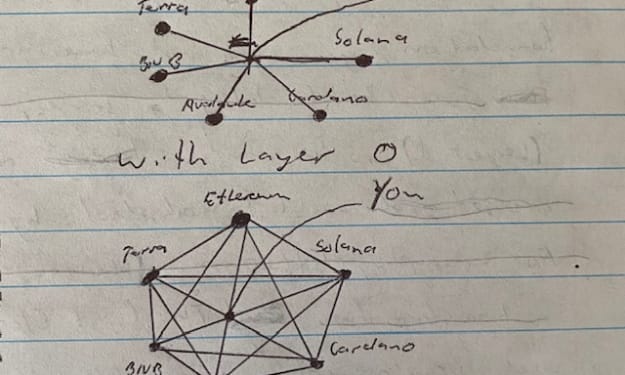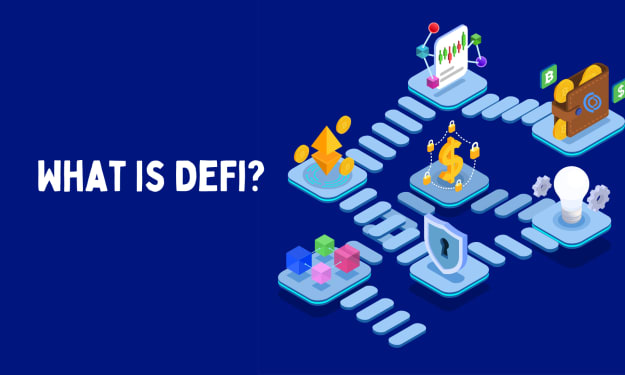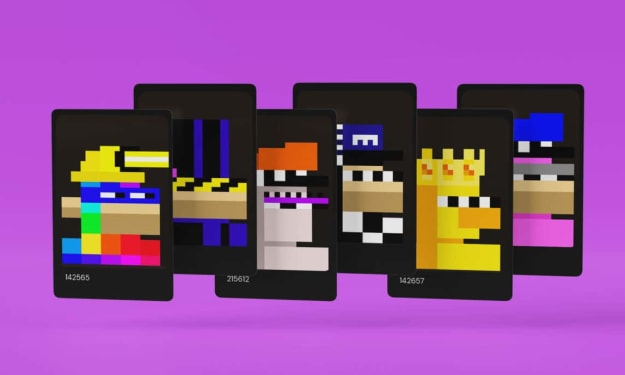DeFi and dapps
The best way to make money in crypto
Decentralized finance, or DeFi, Decentralized applications (dapps) manages financial transactions using cryptocurrencies and blockchain technology. DeFi intends to democratise finance by replacing old, centralised institutions with peer-to-peer connections capable of providing a wide range of financial services, ranging from ordinary banking, loans, and mortgages to complex contractual interactions and asset trading.
To learn all about how you can make money with DeFi as well as have a personal mantor and research team giving you the best picks. Click the link here for more info: https://tinyurl.com/29e7bd76
Finance that is centralised Today
Almost every facet of banking, lending, and trading is now managed through centralised systems run by regulatory organisations and gatekeepers. Consumers must interact with a slew of financial middlemen to obtain anything from auto loans and mortgages to stock and bond trading.

The Federal Reserve and the Securities and Exchange Commission (SEC) determine the rules for the world of centralised financial institutions and brokerages in the United States, and Congress updates the regulations throughout time.
As a result, customers have few options for directly accessing capital and financial services. They can't avoid middlemen such as banks, exchangers, and lenders, who profit from every financial and banking transaction. To play, we must all pay a fee.
Decentralized Finance is the New Way
By disempowering intermediaries and gatekeepers and empowering common people through peer-to-peer trades, DeFi threatens the centralised financial system.
According to Rafael Cosman, CEO and co-founder of TrustToken, "decentralised finance is an unbundling of traditional finance." "DeFi puts important components of today's labour done by banks, exchanges, and insurers—such as lending, borrowing, and trading—in the hands of everyday people."
Here's how it might go down. You can now earn 0.50 percent interest on your funds by putting them in an online savings account. The bank then lends the money to another customer at a rate of 3% interest, pocketing the 2.5 percent profit. DeFi allows people to lend their funds directly to others, eliminating the 2.5 percent profit loss and allowing them to get the full 3 percent return on their investment.
If you want to know more about making money with crypto. Click the link here: https://tinyurl.com/29e7bd76

DeFi is based on the blockchain.
The main technologies that enable decentralised finance are blockchain and cryptocurrencies.
When you make a transaction in a traditional checking account, the transaction is recorded in a secret ledger—your banking transaction history—that is owned and controlled by a huge financial organisation. Blockchain is a distributed, decentralised public ledger that records financial transactions in computer code.
When we say blockchain is distributed, we mean that everyone who uses a DeFi app has an exact copy of the public ledger, which records every transaction in encrypted code. This protects the system by giving users anonymity, as well as payment verification and a record of asset ownership that is (almost) impossible to change through fraudulent behaviour.
When we say blockchain is decentralised, we mean that the system is managed without the use of a mediator or gatekeeper. Through a process of solving complicated math problems and adding new blocks of transactions to the chain, transactions are validated and recorded by parties who use the same blockchain.
DeFi proponents argue that the decentralised blockchain makes financial transactions safer and more transparent than centralised finance's proprietary, opaque methods.

How Is DeFi Being Used? Now
DeFI is being included into a wide range of financial operations, both basic and complicated. It's driven by "dapps," which are decentralised apps, and "protocols," which are other programmes. Transactions in the two largest cryptocurrencies, Bitcoin (BTC) and Ethereum (ETH), are handled via Dapps and protocols (ETH).
While Bitcoin is the most popular cryptocurrency, Ethereum is considerably more adaptable to a larger range of purposes, which means Ethereum-based code is used in a large number of dapps and protocols.

Here are a few examples of how dapps and protocols are now being used:
Financial transactions in the traditional sense. DeFi is being used for everything from payments to trading securities and insurance to lending and borrowing.
Exchanges that are not centralised (DEXs). Most bitcoin investors now use centralised exchanges such as Coinbase or Gemini. DEXs let users to conduct peer-to-peer financial transactions while maintaining control over their funds.
E-wallets. DeFi engineers are developing digital wallets that can function independently of the main cryptocurrency exchanges and provide investors with access to a variety of assets, including bitcoin and blockchain-based games.
Coins that are stable. Stable coins, unlike cryptocurrencies, try to maintain their prices by connecting them to non-cryptocurrencies, such as the US dollar.

Harvesting of yields. DeFi, often known as "rocket fuel," allows speculative investors to lend crypto and potentially profit handsomely when the proprietary coins DeFi borrowing platforms pay them for consenting to the loan appreciate swiftly.
Tokens that aren't fungible (NFTs). NFTs turn non-tradable items like slam dunk videos and the first tweet on Twitter into digital assets. NFTs make the hitherto uncommodifiable commodifiable.
If you want to learn how to use some of these methods to make money click the link here: https://tinyurl.com/29e7bd76
The DeFi market assesses adoption by calculating what's known as locked value, which determines how much money is currently invested in various DeFi protocols. DeFi protocols have a total locked value of about $43 billion at the moment.
The omnipresence of blockchain drives DeFi adoption: a dapp is globally available the moment it is encoded on the blockchain. While most centralised financial instruments and technologies emerge gradually over time, constrained by regional economies' laws and regulations, dapps operate outside of these constraints, raising their potential reward—and also increasing their risks.
The DeFi market assesses adoption by calculating what's known as locked value, which determines how much money is currently invested in various DeFi protocols. DeFi protocols have a total locked value of about $43 billion at the moment.
The omnipresence of blockchain drives DeFi adoption: a dapp is globally available the moment it is encoded on the blockchain. While most centralised financial instruments and technologies emerge gradually over time, constrained by regional economies' laws and regulations, dapps operate outside of these constraints, raising their potential reward—and also increasing their risks.

DeFi's Drawbacks and Risks
DeFi is a new phenomena that comes with a slew of dangers. Decentralized finance is a new concept that hasn't been put to the test for a long time. This will change with regulation from government figures, mainly the SEC.
Collateralization. A valuable item is used as collateral to secure a loan. When you receive a mortgage, for example, the house you're buying serves as collateral. Almost all DeFi lending transactions need collateral equal to, if not more than, 100 percent of the loan's value. Many types of DeFi loans are severely limited due to these constraints.
Requirements for private keys You must secure the wallets used to keep your bitcoin assets while using DeFi with cryptocurrency. Private keys, which are long, unique codes known only to the wallet's owner, safeguard wallets. There is no way to retrieve a lost private key, which means you lose access to your funds.
For your best interest in mind this course will show you all the know-how when it comes to making money with cryptocurrencies: https://tinyurl.com/29e7bd76
How to Become Involved in DeFi
Here are a few places to start if you want to learn more about DeFi in a hands-on way:
Obtain a Cryptocurrency Wallet
"Begin by creating an Ethereum wallet, such as Metamask, and then funding it with Ethereum," Cosman advises. "Self-custody wallets are your ticket to the DeFi world, but save your public and private keys." You won't be able to get back into your wallet if you lose these."

Digital Assets are traded.
Doug Schwenk, chairman of Digital Asset Research, recommends swapping a small amount of two assets on a decentralised market like Uniswap. "Trying this process will assist a crypto enthusiast comprehend the present ecosystem, but be prepared to lose everything while learning which assets and platforms to use," says the author.
Consider Stablecoins.
TrueFi, which offers competitive returns on stablecoins (AKA dollar-backed tokens that aren't subject to market changes), is an intriguing opportunity to check out DeFi without exposing oneself to the price swings of an underlying asset, according to Cosman.
Start slowly, keep humble, and don't get ahead of yourself when venturing into new financial territory. Keep in mind that digital assets exchanged in the cryptocurrency and DeFi worlds are volatile, with a high risk of losing money.
Learn how to mitigate this risk with the course here: https://tinyurl.com/29e7bd76
DeFi in the Future
DeFi's future appears bright, from cutting out the middlemen to turning basketball clips into digital assets with monetary value. That's why, according to Dan Simerman, the IOTA Foundation's head of finance relations, Even though DeFi's capabilities are still in their infancy, a DeFi research and development organisation sees its promise and potential as far-reaching.
Investors will soon get more autonomy, allowing them to "use [assets] in imaginative ways that appear unthinkable today," according to Simerman. According to Simerman, DeFi has significant ramifications for the big data business as it evolves to enable new ways to commodify data.
However, despite its promise, DeFi still has a long way to go, particularly in terms of mass adoption.
"The potential is there," Simerman says. "It's up to us to keep teaching people about the possibilities, but we also need to keep working hard to develop the tools that will enable people to take advantage of them."
Thank you for reading! I hope you learnt a thing or two about DeFi and dapps!
About the Creator
Josh Hillcoat
A crypto and DeFi amateur who will never stop learning about this amazing industry! I wanted a place to document my findings and here seems to be a great spot.






Comments
There are no comments for this story
Be the first to respond and start the conversation.